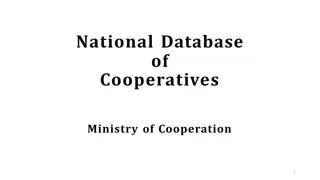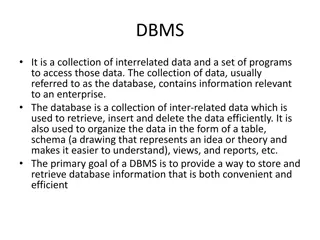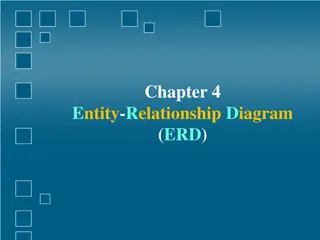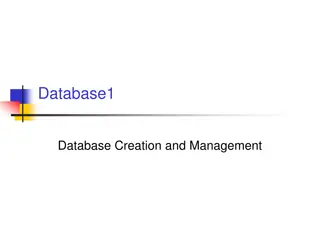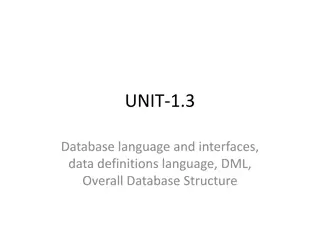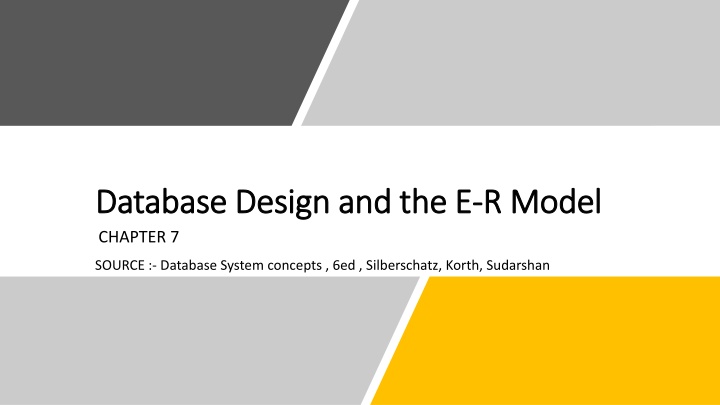
Database Design and the E-R Model: Concepts and Implementation
In the realm of database design and the Entity-Relationship (E-R) model, various fundamental concepts and implementation strategies play crucial roles. This involves designing database schemas, programs for data access and updates, and security protocols. User needs are central in the design process, and phases involve specifying functional and user requirements, abstract data modeling, and conceptual design. The E-R model employs entity sets, relationship sets, and attributes, with associated diagrams. Attributes define properties of entity sets, with domains determining permissible values. The content explores the significance and intricacies of database design using the E-R model.
Download Presentation

Please find below an Image/Link to download the presentation.
The content on the website is provided AS IS for your information and personal use only. It may not be sold, licensed, or shared on other websites without obtaining consent from the author. If you encounter any issues during the download, it is possible that the publisher has removed the file from their server.
You are allowed to download the files provided on this website for personal or commercial use, subject to the condition that they are used lawfully. All files are the property of their respective owners.
The content on the website is provided AS IS for your information and personal use only. It may not be sold, licensed, or shared on other websites without obtaining consent from the author.
E N D
Presentation Transcript
Database Design and the E Database Design and the E- -R Model CHAPTER 7 R Model SOURCE :- Database System concepts , 6ed , Silberschatz, Korth, Sudarshan
Database Design and the E-R Model Database Design Design of the database schema Design of the programs that access and update the data, and Design of a security scheme to control access to data The needs of the users play a central role in the design process Sudha Bhagavatheeswaran, Department of Information Technology, SIES College of Arts, Science & Commerce (Autonomous)
Database Design and the E-R Model Database Design Phases Specification of functional requirements Specification of users requirement Abstract Data model to implementation Conceptual Design REDUNDANCY INCOMPLETENESS Sudha Bhagavatheeswaran, Department of Information Technology, SIES College of Arts, Science & Commerce (Autonomous)
Database Design and the E-R Model Entity Sets and Relationship Sets Entity Sets and Relationship Sets ER DIAGRAM RELATIONSHIP SET ENTITY ENTITY SET Sudha Bhagavatheeswaran, Department of Information Technology, SIES College of Arts, Science & Commerce (Autonomous)
Database Design and the E-R Model Entity-Relationship (E-R) data model The E-R data model employs three basic concepts: entity sets, relationship sets, and attributes The E-R model also has an associated diagrammatic representation, the E-R diagram. An entity is a thing or object in the real world that is distinguishable from all other objects. An entity set is a set of entities of the same type that share the same properties, or attributes. An entity is represented by a set of attributes Each entity has a value for each of its attributes. A relationship is an association among several entities A relationship set is a set of relationships of the same type. The number of entity sets that participate in a relationship set is the degree of the relationship set. A binary relationship set is of degree 2; a ternary relationship set is of degree 3. Sudha Bhagavatheeswaran, Department of Information Technology, SIES College of Arts, Science & Commerce (Autonomous)
Database Design and the E-R Model Attributes Attributes are descriptive properties possessed by each member of an entity set For each attribute, there is a set of permitted values, called the domain, or value set, of that attribute. SIMPLE:- name, total marks COMPOSITE :- name stored as fname,mname,lname ATTRIBUTES Single value :- name Multivalued :- phone number Derived :- age attribute gets its value from the DOB attribute 1 2 3 SIMPLE COMPOSITE SINGLE MULTIVALUED DERIVED Sudha Bhagavatheeswaran, Department of Information Technology, SIES College of Arts, Science & Commerce (Autonomous) Date is a multivalued attribute
Database Design and the E-R Model Mapping Cardinalities Mapping Cardinalities Mapping cardinalities, or cardinality ratios, express the number of entities to which another entity can be associated via a relationship set. For a binary relationship set R between entity sets A and B, the mapping cardinality must be one of the following: One-to-one. An entity in A is associated with at most one entity in B, and an entity in B is associated with at most one entity in A. One-to-many. An entity in A is associated with any number (zero or more) of entities in B. An entity in B, however, can be associated with at most one entity in A Many-to-many. An entity in A is associated with any number (zero or more) of entities in B, and an entity in B is associated with any number (zero or more) of entities in A. Many-to-one. An entity in A is associated with at most one entity in B. An entity in B, however, can be associated with any number (zero or more) of entities in A One to Many One to One (A -> B is O-to-M ; B -> A is O-to-O) (A -> B is O-to-O ; B -> A is O-to-O) Many to Many Many to One (A -> B is O-to-M ; B -> A is O-to-M) (A -> B is O-to-O ; B -> A is O-to-M) Sudha Bhagavatheeswaran, Department of Information Technology, SIES College of Arts, Science & Commerce (Autonomous)
Database Design and the E-R Model Mapping Cardinalities (Primary Key) Mapping Cardinalities (Primary Key) P key from A P key from A or B One to Many One to One (A -> B is O-to-M ; B -> A is O-to-O) (A -> B is O-to-O ; B -> A is O-to-O) P key combination A and B P key from B Many to Many Many to One (A -> B is O-to-M ; B -> A is O-to-M) (A -> B is O-to-O ; B -> A is O-to-M)
Database Design and the E-R Model Participation Constraints The participation of an entity set E in a relationship set R is said to be total if every entity in E participates in at least one relationship in R. If only some entities in E participate in relationships in R, the participation of entity set E in relationship R is said to be partial. STUDENT INSTRUCTOR STUDENT INSTRUCTOR Participation of both A and B in the relationship set are total. Participation of B in the relationship set is total while the participation of A in the relationship set is partial. Sudha Bhagavatheeswaran, Department of Information Technology, SIES College of Arts, Science & Commerce (Autonomous)
Database Design and the E-R Model Weak Entity Sets The entity sets which do not have sufficient attributes to form a primary key are known as weak entity sets and the entity sets which have a primary key are known as strong entity sets. A section is dependent on a course for its existence, which is made explicit by making it a weak entity set. In E-R diagrams, a weak entity set is depicted via a rectangle, like a strong entity set, but there are two main differences: The discriminator of a weak entity is underlined with a dashed, rather than a solid, line. The relationship set connecting the weak entity set to the identifying strong entity set is depicted by a double diamond. The use of double lines to indicate total participation; Sudha Bhagavatheeswaran, Department of Information Technology, SIES College of Arts, Science & Commerce (Autonomous)
Database Design and the E-R Model Entity-Relationship (E-R) diagrams Rectangles divided into two parts represent entity sets. The first part, which in this textbook is shaded blue, contains the name of the entity set. The second part contains the names of all the attributes of the entity set. Diamonds represent relationship sets. Undivided rectangles represent the attributes of a relationship set. Attributes that are part of the primary key are underlined. Lines link entity sets to relationship sets. Dashed lines link attributes of a relationship set to the relationship set. Double lines indicate total participation of an entity in a relationship set. Double diamonds represent identifying relationship sets linked to weak entity sets Sudha Bhagavatheeswaran, Department of Information Technology, SIES College of Arts, Science & Commerce (Autonomous)
Database Design and the E-R Model Codd s Rules(12 rules that a database must obey if it is to Codd s Rules(12 rules that a database must obey if it is to be considered truly relational) be considered truly relational) The The Dynamic online catalog based on the relational model Systematic treatment of null values Guaranteed access rule Information Information rule rule Comprehensive data sublanguage rule View updating rule High-level insert, update, and delete Physical data independence Non subversion rule Distribution independence Logical data independence Integrity independence Sudha Bhagavatheeswaran, Department of Information Technology, SIES College of Arts, Science & Commerce (Autonomous)


